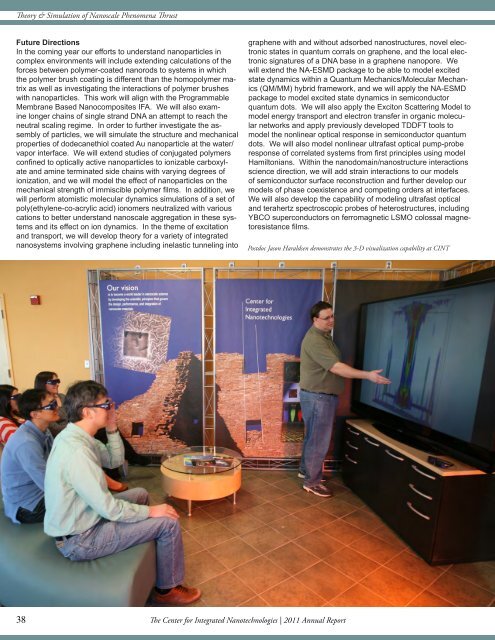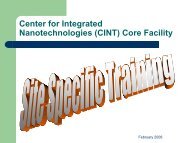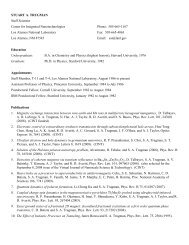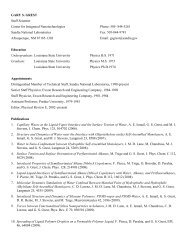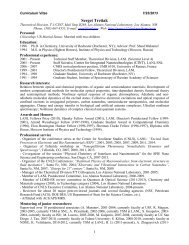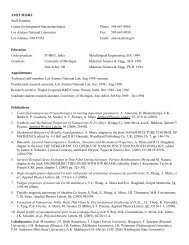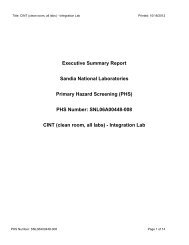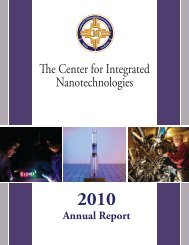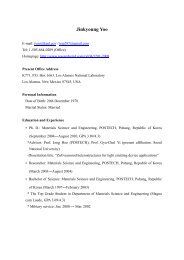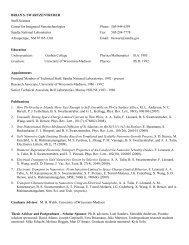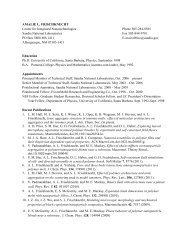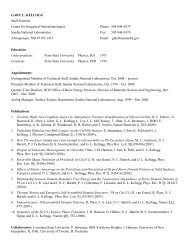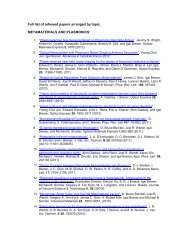2011 Annual Report - Center for Integrated Nanotechnologies - Los ...
2011 Annual Report - Center for Integrated Nanotechnologies - Los ...
2011 Annual Report - Center for Integrated Nanotechnologies - Los ...
You also want an ePaper? Increase the reach of your titles
YUMPU automatically turns print PDFs into web optimized ePapers that Google loves.
Theory & Simulation of Nanoscale Phenomena Thrust<br />
Future Directions<br />
In the coming year our ef<strong>for</strong>ts to understand nanoparticles in<br />
complex environments will include extending calculations of the<br />
<strong>for</strong>ces between polymer-coated nanorods to systems in which<br />
the polymer brush coating is different than the homopolymer matrix<br />
as well as investigating the interactions of polymer brushes<br />
with nanoparticles. This work will align with the Programmable<br />
Membrane Based Nanocomposites IFA. We will also examine<br />
longer chains of single strand DNA an attempt to reach the<br />
neutral scaling regime. In order to further investigate the assembly<br />
of particles, we will simulate the structure and mechanical<br />
properties of dodecanethiol coated Au nanoparticle at the water/<br />
vapor interface. We will extend studies of conjugated polymers<br />
confined to optically active nanoparticles to ionizable carboxylate<br />
and amine terminated side chains with varying degrees of<br />
ionization, and we will model the effect of nanoparticles on the<br />
mechanical strength of immiscible polymer films. In addition, we<br />
will per<strong>for</strong>m atomistic molecular dynamics simulations of a set of<br />
poly(ethylene-co-acrylic acid) ionomers neutralized with various<br />
cations to better understand nanoscale aggregation in these systems<br />
and its effect on ion dynamics. In the theme of excitation<br />
and transport, we will develop theory <strong>for</strong> a variety of integrated<br />
nanosystems involving graphene including inelastic tunneling into<br />
graphene with and without adsorbed nanostructures, novel electronic<br />
states in quantum corrals on graphene, and the local electronic<br />
signatures of a DNA base in a graphene nanopore. We<br />
will extend the NA-ESMD package to be able to model excited<br />
state dynamics within a Quantum Mechanics/Molecular Mechanics<br />
(QM/MM) hybrid framework, and we will apply the NA-ESMD<br />
package to model excited state dynamics in semiconductor<br />
quantum dots. We will also apply the Exciton Scattering Model to<br />
model energy transport and electron transfer in organic molecular<br />
networks and apply previously developed TDDFT tools to<br />
model the nonlinear optical response in semiconductor quantum<br />
dots. We will also model nonlinear ultrafast optical pump-probe<br />
response of correlated systems from first principles using model<br />
Hamiltonians. Within the nanodomain/nanostructure interactions<br />
science direction, we will add strain interactions to our models<br />
of semiconductor surface reconstruction and further develop our<br />
models of phase coexistence and competing orders at interfaces.<br />
We will also develop the capability of modeling ultrafast optical<br />
and terahertz spectroscopic probes of heterostructures, including<br />
YBCO superconductors on ferromagnetic LSMO colossal magnetoresistance<br />
films.<br />
Postdoc Jason Haraldsen demonstrates the 3-D visualization capability at CINT<br />
38<br />
38The <strong>Center</strong> <strong>for</strong> <strong>Integrated</strong> <strong>Nanotechnologies</strong> | <strong>2011</strong> <strong>Annual</strong> <strong>Report</strong>


